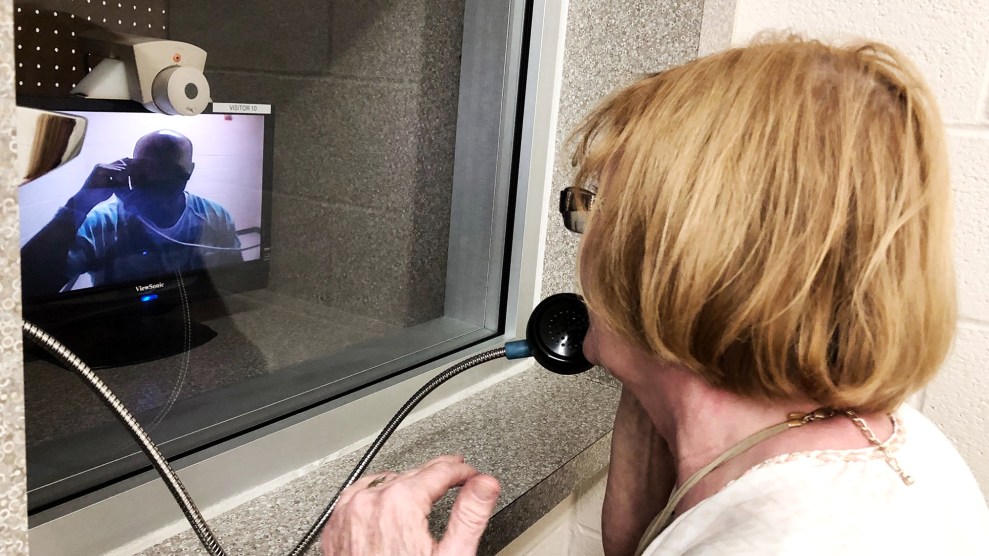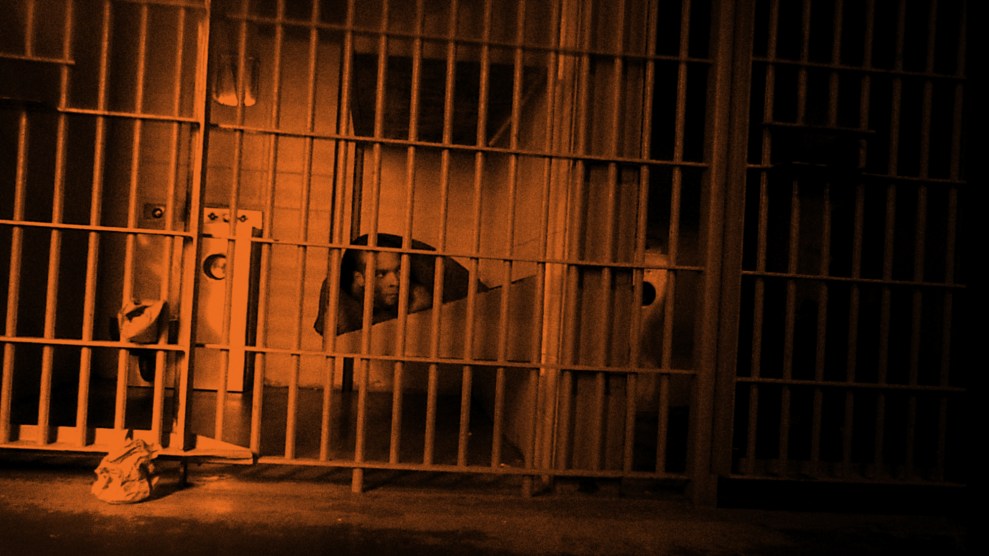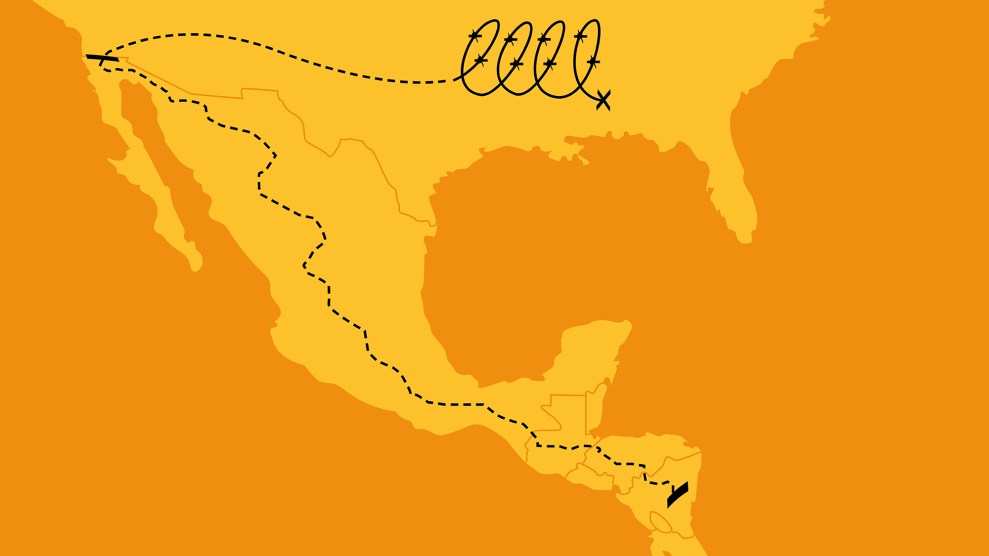
Mother Jones illustration
On a December morning in Tijuana, Isaac Molina and his family stood in a line of migrants waiting to be allowed into the United States to seek asylum. His case for protection was thoroughly documented—the gunshot wounds in his abdomen and back, at the hands of the Nicaraguan police, were more tangible evidence than most asylum seekers have—and he assumed their four-month journey from Nicaragua was coming to an end.
Seven weeks later, Molina is incarcerated in a prison in Mississippi for the crime of making a legal claim for asylum.
It might seem odd that a man seeking protection from a regime condemned by the Trump administration would end up imprisoned at the remote Tallahatchie County Correctional Facility, which is run by a notorious private prison company. But Molina’s story is part of a secretive effort by Immigration and Customs Enforcement to expand its network of crowded detention centers by housing more and more immigrants making legal asylum claims at jails and prisons around the country. Hundreds of those asylum seekers are now incarcerated at Tallahatchie, far from anyone they know and the legal services they need.
The closest city to Tallahatchie is Memphis, 90 miles to the north. CoreCivic, the private prison giant that runs Tallahatchie, has traditionally used the 2,672-person prison to hold criminals sent by state governments across the country facing space shortages in their own facilities. But when CoreCivic said last year that California would remove its 1,300 inmates from Tallahatchie amid an effort to end its use of out-of-state prisons, the company found a new population of inmates to make up for the shortfall: In June, it signed a contract that allows ICE and the US Marshals Service to incarcerate up to 1,350 people at the prison.
ICE’s experiment at Tallahatchie has been carried out with little transparency or oversight. Congress required ICE in 2018 to publish basic information about the jails and detention centers it uses, but the agency has kept Tallahatchie off that list. ICE declined to say how many migrants it is holding at the prison. Across the country, the agency held a record 49,000 people in detention this month, even though Congress has provided funding for only 40,520 detention beds. New contracts like the one at Tallahatchie are allowing ICE to exceed the limits Congress has tried to impose.
Many, if not most, of the ICE detainees replacing convicted criminals at Tallahatchie are asylum seekers from around the world. Since Mississippi does not have a history of immigration detention, access to legal counsel at Tallahatchie is severely limited; the American Immigration Lawyers Association’s website lists no immigration attorneys within 50 miles of the prison. Lawyers who have worked at the facility say there are not enough Spanish-speaking staff members at the prison, let alone those who speak the native languages of asylum-seekers from Africa and South Asia. Jeremy Jong, a staff attorney at the Southern Poverty Law Center who has visited the prison, says in an email, “If someone wanted to build a jail where asylum-seekers lose otherwise winnable cases because of lack of access to the outside world, that jail would probably look a lot like Tallahatchie does now.”
Before leaving Managua, Molina worked at an insurance company in one of the tallest buildings in the capital and Molina’s partner Fabiola worked as a manager in the government’s social security department. They shared a car, a home, and a comfortable life with Fabiola’s two youngest children, a 12-year-old boy and a 6-year-old girl.
On April 18, an anti-government protest took place near Molina’s home. When he heard gunshots, he drove over on his motorcycle and saw a young man bleeding out from a bullet to the throat. Molina had grown up in a family that supported President Daniel Ortega’s left-wing Sandinista party, but his politics quickly changed after the protest. He joined other first responders in treating protesters injured by pro-government forces. That, he said, angered Ortega supporters. In late May, Molina was at home when he heard something strike his front gate. He saw a half-dozen people outside. “I’m a doctor,” he shouted.
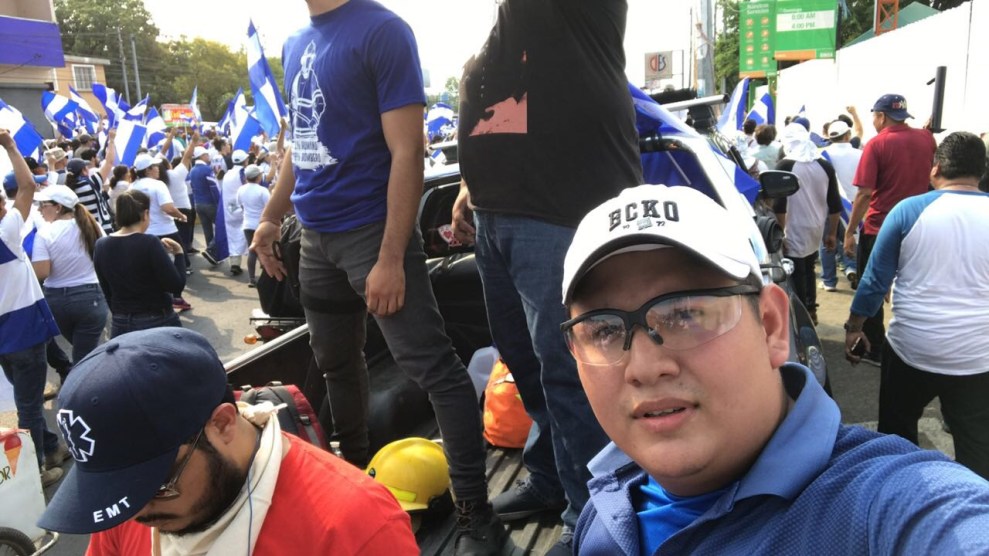
Molina volunteering as a paramedic at a protest in Nicaragua in May
Isaac Molina
One of them told him, “You’re going to die,” he later recalled. Soon after, the police picked him up and said “something” would happen to him if he continued treating anti-regime demonstrators.
On June 29, the police stopped Molina on his way to work. One officer told Molina to follow him and another climbed into his passenger seat. They drove to a spot near the national stadium and were soon met by a pickup truck carrying masked men. One of the men said it was time to “finish” things and shot Molina in the abdomen. That, apparently, had not been the plan. Another man interjected, “Not here.” Molina took advantage of the disagreement to make his escape, but the men shot at him again as he fled, striking him in the back.
Molina made a panicked call to a group of doctors, who took him to the hospital. A surgeon performed a laparotomy, a major incision to the abdomen, and discovered no damage to Molina’s organs. A doctor in Nicaragua, who requested anonymity due to fear of government retribution, told me that a full recovery from the operation takes a year.

Molina after his laparotomy
Courtesy of Fabiola
While Molina was still in the hospital, a Nicaraguan human rights group connected him with the Inter-American Commission on Human Rights, an autonomous arm of the Organization of American States, which then issued an alert stating that Molina and his family’s lives appeared to be in danger. María Isabel Rivero, the IAHCR’s communicators director, says her organization received 388 requests to issue these alerts in Nicaragua last year but granted only 67 of them, including Molina’s. After leaving the hospital, he went into hiding.
In August, after he’d recovered enough to travel, Molina fled to El Salvador with his family, and from there to Mexico. I first met Molina in Tijuana on December 27, when he and his family were about to cross the border into the United States after waiting six weeks in Mexico for permission to request asylum. Then I didn’t hear from them until a month later, when Fabiola texted me from Alabama and told me Molina was in detention.

Molina on his way to the Mexican immigration van that took him to the United States
Noah Lanard/Mother Jones
Upon entering the United States, Molina explained later, he told a Customs and Border Protection officer that he and Fabiola were married but had never received the official paperwork. Justine Whelan, an ICE spokeswoman, says Molina was separated from his family because he stated during his initial processing that he had entered the United States by himself. Molina disputes that. “I never said I had entered alone,” he says. “I always said I came with my family.”
CBP released Fabiola and her kids from a holding facility, where the lights are kept on 24 hours a day, after two and a half days. Molina had to stay there for more than a week, far longer than the 72 hours that CBP policy generally allows. He was transferred first to Arizona and then to Mississippi. In both states he was hospitalized, for chest pain related to a heart condition and for a sinus infection.
Fabiola and her children rode a Greyhound bus more than 2,000 miles to join her sister and brother-in-law, both of whom are US citizens, in Alabama. Soon after, she received her first call from Molina in Tallahatchie. Perversely, the call would have cost her much less if Molina had been a criminal: Some recipients of calls from criminals in the prison pay 7 cents per minute, according to a customer service representative for Tallahatchie’s phone provider, while those speaking with immigration detainees have to pay 21 cents a minute, a rate that further limits detainees’ contact with the outside world.
On January 17, Molina passed his “credible fear” interview, the first step in the asylum process, which meant he had demonstrated a significant risk of persecution in Nicaragua and could proceed to make his official asylum claim. The decision made him eligible to be released on parole by ICE, but the agency quickly declined to do so. Parole for asylum seekers who passed their credible fear interviews used to be routine, but the Trump administration has moved toward universal detention of asylum seekers. A federal judge ruled last summer that ICE was violating its own policies by denying parole to almost everyone who requested it at five ICE field offices. ICE often argues that people can’t be released on parole because they lack ties to people in the United States. That is not the case for Molina: Along with Fabiola’s family, his mother, a green card holder who lives in California, has told ICE she is able to assist her son.
Christina Swatzell, the co-director of legal services at Latino Memphis, the only nonprofit in the region that represents ICE detainees at Tallahatchie, says she is not aware of any cases in which ICE released someone from Tallahatchie on parole. Neither is Assma Ali, a Mississippi immigration attorney who represents people at the prison.
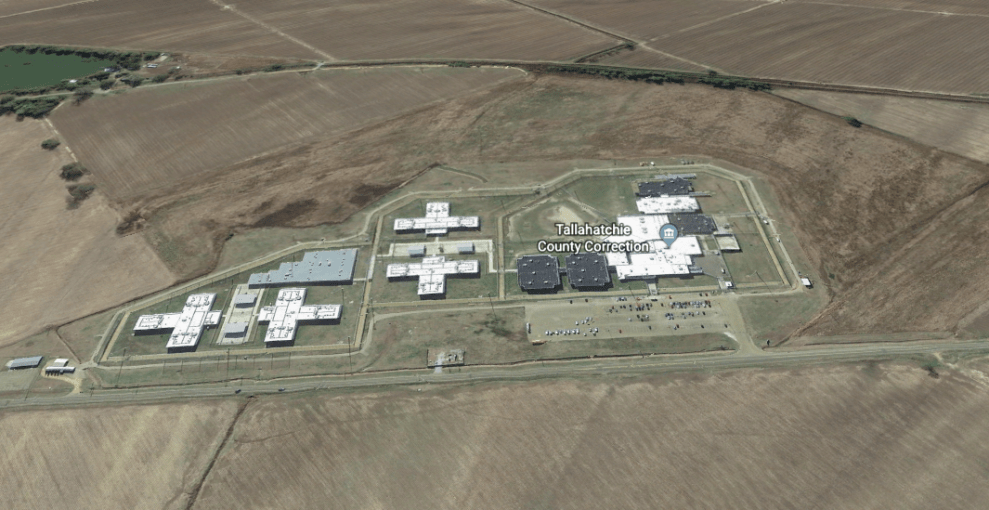
A satellite view of the Tallahatchie County Correctional Facility
Google Earth
Tallahatchie is not a typical detention center where migrants are held for the duration of their cases. Instead, it serves as a stopping-off point where asylum seekers go through the credible fear process before being transferred to detention centers that have access to immigration courts. The idea is to hold immigrants for brief periods, but some can end up staying for months. Jong, the SPLC attorney, says detainees at Tallahatchie suffer from a severe sense of isolation. Most detainees he talks to don’t know where they are in the United States and are surprised when he shows them a map.
Even basic information about the detention center is hard to come by. Asked how many migrants are detained at Tallahatchie, Whelan said the agency tracks detainees regionally and provided the number for the New Orleans area. ICE does track how many people it has at individual detention centers and posts that information on its website, but the current spreadsheet does not include Tallahatchie.
CoreCivic CEO Damon Hininger told investors on a November earnings call that the Marshals Service and ICE each held 600 inmates at Tallahatchie. The company’s chief financial officer said on the call that the federal detainees had “essentially replaced the California inmate populations.” CoreCivic struck a similar deal in July at the La Palma Correctional Center in Arizona, under which ICE detainees are helping make up for inmates being withdrawn by California. Hininger made clear on the November call that his company can “activate idle facilities” if “ICE continue[s] to have increased needs for detention space.”
CoreCivic, formerly known as the Corrections Corporation of America, has a well-documented history of maximizing profits through cuts to prison services. In 2016, Mother Jones reporter Shane Bauer’s award-winning investigation exposed severe understaffing and grossly inadequate medical attention at a CCA prison in Louisiana. The health services administrator at CoreCivic’s Stewart immigration detention center in rural Georgia said in 2016 that the facility had “chronic shortages of almost all medical staff positions.” A company supervisor described the facility as a “ticking bomb” because noncriminal detainees were often mistakenly housed with felons.
Jong says many migrants at Tallahatchie have complained about how long it takes to get a response to their medical requests, if they receive one at all. Molina believes he has a hernia related to his laparotomy and says the inflammation around his gunshot wound is getting worse. Fabiola’s brother-in-law, a doctor in Birmingham, wrote to ICE last month, “Based on his recent medical history, including a gunshot wound to his abdomen, and his acute…chronic abdominal pain, I think it would be best for him to be seen by a general surgeon.” Molina submitted 14 requests for medical treatment in as many days. He says he never received a response. Molina told me Wednesday that he stopped submitting the requests last week after a guard began refusing to give him the required form.
Amanda Gilchrist, CoreCivic’s director of public affairs, disputes Molina’s account. She says it is “false” that Molina did not receive a response to his medical requests and that he saw a medical provider eight times between January 11 and February 13. Whelan said earlier this month that Molina had “not complained to ICE medical providers of issues pertaining to gunshot wounds.” Molina told me about dental and mental health checks at Tallahatchie, as well as a visit to the prison infirmary, but does not consider that medical attention a response to the problems described in his requests.
Last month, Molina says, a Cameroonian migrant in the prison tried to commit suicide by hanging himself with a bed sheet. Molina identified himself as a doctor and attended to the man until nurses arrived. He says ICE officers came to his cell afterward and thanked him for his help. On Saturday, an inmate from Wyoming serving a life sentence died by apparent suicide at Tallahatchie.
The painful irony for Molina is that he fled to the United States after defying a regime that the Trump administration has criticized and targeted with economic sanctions. But it has made no difference to ICE. If he ultimately receives asylum, ICE will have spent untold thousands of dollars keeping him apart from his family for months for no purpose.
While he was still in El Salvador, Molina said the medical attention he had provided in Nicaragua was worth the pain it had caused him. “I never did anything wrong,” he told a reporter from Univision. “Taking care of patients is your vocation—you took an oath to do that—I don’t regret it.”
Now he is just hoping to move on. “As soon as I left my country, I knew I wasn’t going back,” he told me. “Maybe when my papers are in completely in order, I can go back to having a normal life. That’s what I want the most: to have a normal life.”

